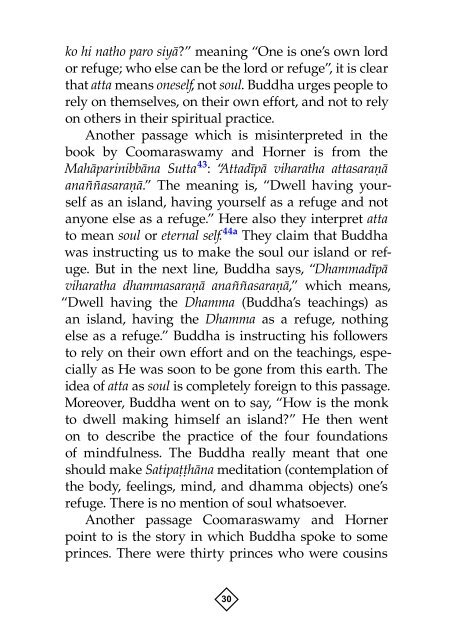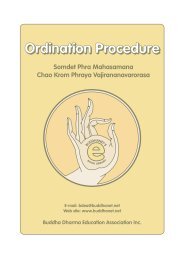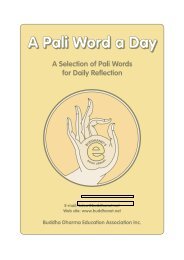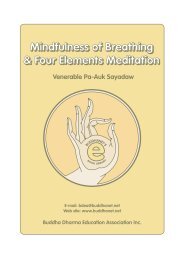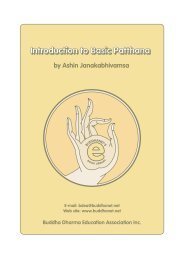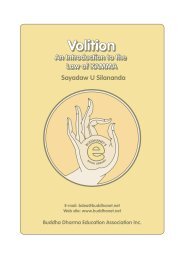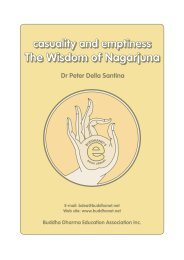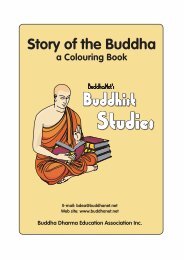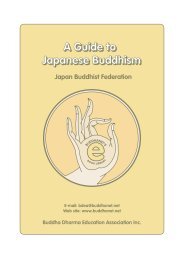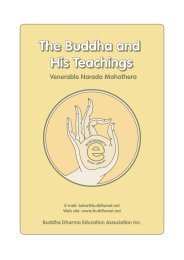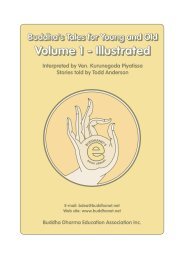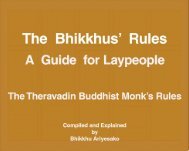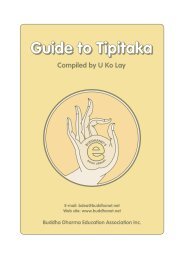No Inner Core: An Introduction to the Doctrine of Anatta - BuddhaNet
No Inner Core: An Introduction to the Doctrine of Anatta - BuddhaNet
No Inner Core: An Introduction to the Doctrine of Anatta - BuddhaNet
You also want an ePaper? Increase the reach of your titles
YUMPU automatically turns print PDFs into web optimized ePapers that Google loves.
ko hi natho paro siyà?” meaning “One is one’s own lord<br />
or refuge; who else can be <strong>the</strong> lord or refuge”, it is clear<br />
that atta means oneself, not soul. Buddha urges people <strong>to</strong><br />
rely on <strong>the</strong>mselves, on <strong>the</strong>ir own effort, and not <strong>to</strong> rely<br />
on o<strong>the</strong>rs in <strong>the</strong>ir spiritual practice.<br />
<strong>An</strong>o<strong>the</strong>r passage which is misinterpreted in <strong>the</strong><br />
book by Coomaraswamy and Horner is from <strong>the</strong><br />
Mahàparinibbàna Sutta 43 : “Attadãpà viharatha attasaraõà<br />
ana¤¤asaraõà.” The meaning is, “Dwell having yourself<br />
as an island, having yourself as a refuge and not<br />
anyone else as a refuge.” Here also <strong>the</strong>y interpret atta<br />
<strong>to</strong> mean soul or eternal self. 44a They claim that Buddha<br />
was instructing us <strong>to</strong> make <strong>the</strong> soul our island or refuge.<br />
But in <strong>the</strong> next line, Buddha says, “Dhammadãpà<br />
viharatha dhammasaraõà ana¤¤asaraõà,” which means,<br />
“Dwell having <strong>the</strong> Dhamma (Buddha’s teachings) as<br />
an island, having <strong>the</strong> Dhamma as a refuge, nothing<br />
else as a refuge.” Buddha is instructing his followers<br />
<strong>to</strong> rely on <strong>the</strong>ir own effort and on <strong>the</strong> teachings, especially<br />
as He was soon <strong>to</strong> be gone from this earth. The<br />
idea <strong>of</strong> atta as soul is completely foreign <strong>to</strong> this passage.<br />
Moreover, Buddha went on <strong>to</strong> say, “How is <strong>the</strong> monk<br />
<strong>to</strong> dwell making himself an island?” He <strong>the</strong>n went<br />
on <strong>to</strong> describe <strong>the</strong> practice <strong>of</strong> <strong>the</strong> four foundations<br />
<strong>of</strong> mindfulness. The Buddha really meant that one<br />
should make Satipaññhàna meditation (contemplation <strong>of</strong><br />
<strong>the</strong> body, feelings, mind, and dhamma objects) one’s<br />
refuge. There is no mention <strong>of</strong> soul whatsoever.<br />
<strong>An</strong>o<strong>the</strong>r passage Coomaraswamy and Horner<br />
point <strong>to</strong> is <strong>the</strong> s<strong>to</strong>ry in which Buddha spoke <strong>to</strong> some<br />
princes. There were thirty princes who were cousins<br />
30


